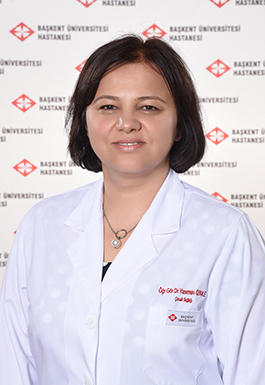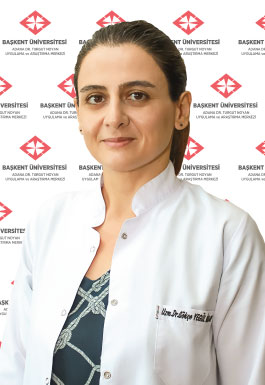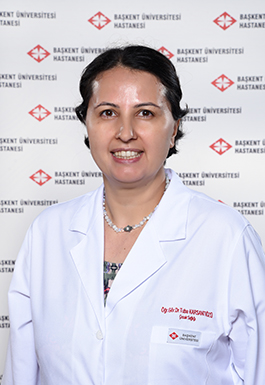General Pediatrics and Pediatric Intensive Care
The department of pediatric health and diseases aims to ensure the normal growth and development of children, and to combat all kinds of diseases and problems that may affect children's health. Our department serves an important patient group at Başkent Seyhan Hospital with a multidisciplinary approach, including general pediatrics, pediatric neurology, pediatric gastroenterology, pediatric nephrology, pediatric hematology and oncology, pediatric endocrinology, pediatric cardiology, pediatric emergency, neonatology, and pediatric intensive care.
The general pediatrics department consists of an associate professor, four faculty members, and a specialist doctor, providing services to children aged 0-18. In the general pediatrics clinics located on the -1 and 6th floors of the Seyhan Hospital building, every patient's height, weight, head circumference (before the age of 2), blood pressure, and temperature (if necessary) are measured and recorded before the examination. The growth of patients is primarily evaluated by comparing their height and weight with other children of the same age and their own previous results. It should be remembered that the best indicator of a child's health is their normal growth.
In the outpatient clinic services, a detailed physical examination is conducted after taking a sufficient history related to the patient's complaints, and laboratory tests are initiated if necessary. Our hospital is equipped to perform all kinds of laboratory tests and radiological examinations that support the diagnoses we consider. Additionally, consultations with related sub-departments are sought for patients when necessary. Patients requiring hospitalization are observed in the pediatrics ward located on the 7th floor of our hospital. Our pediatric ward has double rooms, each equipped with a toilet and bathroom. The attending physician evaluates the patient during morning and evening rounds and provides detailed information to the parent about the patient's condition. During the day, a floor doctor and at night, a specialist and a general practitioner closely monitor and treat the patients. The general pediatrics department diagnoses, treats, and follows up on various diseases such as upper respiratory tract infections, pneumonia, bronchiolitis, otitis media, asthma, diarrhea, meningitis, rash diseases, febrile seizures, urinary tract infections, reflux, and more. Regular pediatric health monitoring by pediatric specialists in clinics is the most important part of primary health care services. Pediatric health monitoring should continue at periodic intervals until the age of 18.
The period from birth to the end of the second year is the most critical for healthy growth and development, as it is the time when growth and development are fastest in children. Therefore, pediatric health monitoring is done more frequently in the first 2 years. In our hospital, newborn babies are evaluated by a specialist at birth and 48 hours after birth. After providing necessary recommendations and information about breastfeeding, babies are called for a clinic check-up on the 5-7th day for hearing tests, vision tests, hypothyroidism screening, and jaundice screening if necessary. Parents are given information about baby nutrition and care, breastfeeding, newborn jaundice, and vaccinations, and their questions are answered. Vitamin D supplementation is started during this period.
In our hospital, pediatric health monitoring frequency is once a month in the first 6 months and once every three months in the second 6 months. Hip ultrasonography for congenital hip dysplasia is routinely performed at the 3rd month. As time progresses, pediatric health monitoring continues once a year at 18, 24, 30, 36 months, and until the age of 6, and then once a year until the age of 18. At one year of age, blood values are checked for anemia and vitamin deficiencies, abdominal ultrasonography is performed for organomegaly, and echocardiography is evaluated for possible cardiac pathologies if not previously done. At each check-up, healthy nutrition recommendations are made to help children develop proper eating habits. It should be remembered that the foundation of nutrition habits is laid in childhood. Children who acquire proper nutrition habits will be better protected from diseases and will experience a healthier and faster growth and development process.
Our hospital's pediatric emergency department consists of 3 outpatient rooms, 1 intervention room, and 2 observation rooms with a total of 9 beds. Every patient who presents to the emergency department is greeted by an emergency nurse, and their vital signs are measured and recorded before being taken to the examination room. Patients with emergency conditions are given priority and taken to the intervention room by the emergency physician for initial assessment and treatment, then moved to the observation room for necessary tests and treatment. Patients who have completed emergency treatment are discharged with a prescription. Patients requiring hospitalization are evaluated by the emergency department consultant specialist and their follow-up and treatment are arranged before being admitted to the ward. Patients followed by sub-departments are first evaluated by the emergency physician when they present to the emergency department and then consulted with the relevant department for opinions and recommendations. The emergency department is staffed by 2 general practitioners and 1 specialist physician during night shifts.
Our hospital's pediatric intensive care unit consists of 10 beds. The intensive care unit has 2 isolation rooms for patients who need to be isolated. The pediatric intensive care unit, which treats critically ill children aged 1 month to 18 years, is staffed by an associate professor and a general practitioner. Our unit, equipped with advanced technology and providing advanced life support, monitors diseases that require advanced life support. Each patient is monitored with an advanced monitoring system at their bedside. The pediatric intensive care unit treats patients with severe respiratory failure needing mechanical ventilation or high-flow oxygen therapy (asthma, bronchiolitis, pneumonia, muscular diseases), patients requiring renal support therapy (dialysis, hemodiafiltration, etc.), patients with severe heart failure and circulatory failure, patients requiring plasma exchange for severe neurological and nephrological diseases, patients with status epilepticus or intracranial hypertension syndrome, patients with severe central nervous system infections such as meningitis or encephalitis, patients with altered consciousness, patients with diabetic ketoacidosis, critically ill hematological and oncological patients, patients with gastrointestinal bleeding, acute liver failure, patients requiring follow-up and treatment after liver transplantation, patients with sepsis and septic shock, poisonings (drugs, toxic substances, insect stings, etc.), and trauma patients. In addition, critical patient monitoring, follow-up, and treatment before and after surgery are performed by pediatric surgery. Patients are consulted with sub-departments according to their underlying disease condition for multidisciplinary monitoring. Catheter insertion is performed at the bedside by a pediatric intensive care specialist for necessary patients. During the information hour, patient relatives are allowed into the intensive care unit, and the responsible doctor provides information about the patient at the bedside. During night shifts, one specialist physician and one floor physician continue to provide uninterrupted intensive care service.




